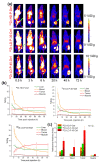HPMA Copolymer-Based Nanomedicines in Controlled Drug Delivery
- PMID: 33578756
- PMCID: PMC7916469
- DOI: 10.3390/jpm11020115
HPMA Copolymer-Based Nanomedicines in Controlled Drug Delivery
Abstract
Recently, numerous polymer materials have been employed as drug carrier systems in medicinal research, and their detailed properties have been thoroughly evaluated. Water-soluble polymer carriers play a significant role between these studied polymer systems as they are advantageously applied as carriers of low-molecular-weight drugs and compounds, e.g., cytostatic agents, anti-inflammatory drugs, antimicrobial molecules, or multidrug resistance inhibitors. Covalent attachment of carried molecules using a biodegradable spacer is strongly preferred, as such design ensures the controlled release of the drug in the place of a desired pharmacological effect in a reasonable time-dependent manner. Importantly, the synthetic polymer biomaterials based on N-(2-hydroxypropyl) methacrylamide (HPMA) copolymers are recognized drug carriers with unique properties that nominate them among the most serious nanomedicines candidates for human clinical trials. This review focuses on advances in the development of HPMA copolymer-based nanomedicines within the passive and active targeting into the place of desired pharmacological effect, tumors, inflammation or bacterial infection sites. Specifically, this review highlights the safety issues of HPMA polymer-based drug carriers concerning the structure of nanomedicines. The main impact consists of the improvement of targeting ability, especially concerning the enhanced and permeability retention (EPR) effect.
Keywords: EPR effect; HPMA copolymers; controlled release; drug delivery; nanomedicines.
Conflict of interest statement
The authors declare no conflict of interest.
Figures







Similar articles
-
HPMA Copolymer-Drug Conjugates with Controlled Tumor-Specific Drug Release.Macromol Biosci. 2018 Jan;18(1). doi: 10.1002/mabi.201700209. Epub 2017 Aug 14. Macromol Biosci. 2018. PMID: 28805040 Review.
-
Highly effective anti-tumor nanomedicines based on HPMA copolymer conjugates with pirarubicin prepared by controlled RAFT polymerization.Acta Biomater. 2020 Apr 1;106:256-266. doi: 10.1016/j.actbio.2020.02.011. Epub 2020 Feb 11. Acta Biomater. 2020. PMID: 32058082
-
Nanomedicines Meet Disordered Proteins: A Shift from Traditional Materials and Concepts to Innovative Polymers.J Pers Med. 2022 Oct 6;12(10):1662. doi: 10.3390/jpm12101662. J Pers Med. 2022. PMID: 36294800 Free PMC article.
-
The structure of polymer carriers controls the efficacy of the experimental combination treatment of tumors with HPMA copolymer conjugates carrying doxorubicin and docetaxel.J Control Release. 2017 Jan 28;246:1-11. doi: 10.1016/j.jconrel.2016.12.004. Epub 2016 Dec 6. J Control Release. 2017. PMID: 27940304
-
Do HPMA copolymer conjugates have a future as clinically useful nanomedicines? A critical overview of current status and future opportunities.Adv Drug Deliv Rev. 2010 Feb 17;62(2):272-82. doi: 10.1016/j.addr.2009.12.005. Epub 2009 Dec 11. Adv Drug Deliv Rev. 2010. PMID: 20005271 Review.
Cited by
-
Innovative approaches to asthma treatment: harnessing nanoparticle technology.Discov Nano. 2025 Feb 8;20(1):21. doi: 10.1186/s11671-025-04211-z. Discov Nano. 2025. PMID: 39922940 Free PMC article. Review.
-
P(LMA-co-tBMA-co-MAA) Copolymers Bearing Amphiphilic and Polyelectrolyte Characteristics: Synthetic Aspects and Properties in Aqueous Solutions.Polymers (Basel). 2025 May 26;17(11):1473. doi: 10.3390/polym17111473. Polymers (Basel). 2025. PMID: 40508715 Free PMC article.
-
Biodegradable Covalently Crosslinked Poly[N-(2-Hydroxypropyl) Methacrylamide] Nanogels: Preparation and Physicochemical Properties.Polymers (Basel). 2024 Jan 17;16(2):263. doi: 10.3390/polym16020263. Polymers (Basel). 2024. PMID: 38257062 Free PMC article.
-
Designing Drug Delivery Vehicles based on N-(2-Hydroxypropyl) Methacrylamide.Curr Comput Aided Drug Des. 2025;21(3):302-315. doi: 10.2174/0115734099278986231228070823. Curr Comput Aided Drug Des. 2025. PMID: 38284714
-
Stimuli-responsive nano vehicle enhances cancer immunotherapy by coordinating mitochondria-targeted immunogenic cell death and PD-L1 blockade.Acta Pharm Sin B. 2022 May;12(5):2533-2549. doi: 10.1016/j.apsb.2021.11.005. Epub 2021 Dec 29. Acta Pharm Sin B. 2022. PMID: 35646521 Free PMC article.
References
-
- Chytil P., Kostka L., Etrych T. Structural design and synthesis of polymer prodrugs. In: Scholz C., editor. Polymers for Biomedicine: Synthesis, Characterization, and Applications. John Wiley and Sons; Hoboken, NJ, USA: 2017. p. 624.
Publication types
Grants and funding
LinkOut - more resources
Full Text Sources
Other Literature Sources

